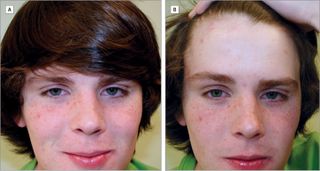How Justin Bieber's Bangs Could Save Teens' Skin

Bangs that sweep across the forehead may be more than fashionable — the hairstyle that celebrity Justin Bieber brought back can provide doctors with a unique opportunity to talk to teens about sun protection, experts say.
Doctors at Johns Hopkins Hospital recently made in interesting discovery in some of their teen patients with the Bieber hairstyle: stark differences between the skin covered by bangs and the skin on the rest of their faces. The skin under the bangs was paler, and had almost no freckles, while freckles covered the skin on the patients' cheeks and noses.
Freckles themselves aren't harmful, but they are markers of sun damage, and are linked with an increased risk of melanoma in adults, said Dr. Bernard Cohen, a professor of dermatology and pediatrics at Johns Hopkins. [7 Beauty Trends that Are Bad for Your Health]
Cohen and his colleague Dr. Crystal Agi dubbed the phenomenon the "big bang theory," and realized they could use the hairstyle to teach kids about the skin damage that occurs when they don't cover up in the sun.
It's "a gimmicky way to make them smile and engage them in a conversation about sun protection," Cohen said.

This discussion includes what teens can do to protect themselves from the sun, such as using of sunscreen, hats and sun-protective clothing, and avoiding the mid-day sun when possible, Cohen said.
Discussions with teens about sun protection can be difficult, because many young people do not care about an increased risk of skin cancer that may be decades away, he said. "But they do care about wrinkles [and] things that make them look old," which are also risks of sun exposure, he said.
Sign up for the Live Science daily newsletter now
Get the world’s most fascinating discoveries delivered straight to your inbox.
Despite the protective effect of the bangs seen in some patients, teens with the hairstyle should still use sunscreen on their whole faces, and not rely on bangs for sun protection, Cohen said.
Cohen and Agi published their "big bang theory" in the July issue of the journal JAMA Pediatrics.
Follow Rachael Rettner @RachaelRettner. Follow Live Science @livescience, Facebook & Google+. Original article on Live Science.

Rachael is a Live Science contributor, and was a former channel editor and senior writer for Live Science between 2010 and 2022. She has a master's degree in journalism from New York University's Science, Health and Environmental Reporting Program. She also holds a B.S. in molecular biology and an M.S. in biology from the University of California, San Diego. Her work has appeared in Scienceline, The Washington Post and Scientific American.










